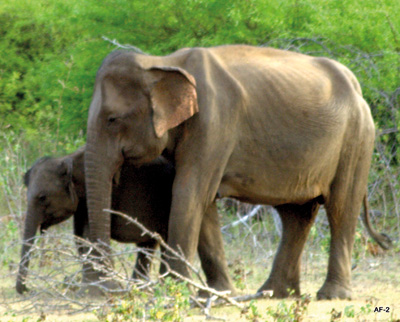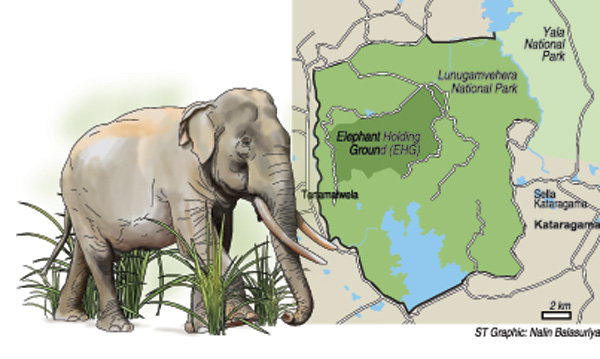News
‘White elephant’ concentration camp for problem jumbos
The proposed $5 million elephant holding ground inside Lunugamwehera National Park for so-called problem elephants has drawn criticism from environmentalists who say it will become a prison and also harm free-ranging elephants in the park.

Starving elephants of Lunugamwehera soon after Elephant Drive in 2005
The Sunday Times has learned that the World Bank, which was to fund the project, withdrew its offer because the Department of Wildlife Conservation (DWC) did not conduct Environmental Impact Assessment and other prerequisites.
The DWC has named this facility the Problem Elephant Rehabilitation Centre (PERC) intending to keep in it the elephants that repeatedly cause excessive crop and property damage and attack humans.
The standard solution to this problem has been to move the animals to a protected area in a different location. But scientific study has proved translocations are a failure as such elephants often leave those areas and create human-elephant conflict elsewhere.
The department is under severe public and political pressure to capture and translocate such elephants, so, with options running out, it has again opted for another elephant holding ground.
If the project goes ahead, it would be the third time an elephant holding ground has been set up.
The first holding ground in Lunugamvehera proved to be a complete failure as all the elephants escaped.
Then, according to the wildlife department, more than 46 elephants were put into the Horowpathana holding ground commissioned in 2015.
It is alleged, however, that no monitoring of these animals has been carried out except for three elephants being fitted with electronic collars. Of these three, one escaped, one died of starvation and the other’s collar fell off after a short period.
According to the new plan, 3500 ha in the centre of Lunugamwehera National Park is to be encircled with an 11-foot-high electric fence. The park is 23,498 ha in extent, with forest ranges extending from it.
The DWC says the amount of forest taken away would not affect the existing elephant population in the park. Past data, however, predicts a different picture.
During an infamous elephant drive held in 2005, about 200 elephants were driven to the Lunugamwehera National Park. Many of them starved to death as the resources of the park were inadequate.
Environmentalists fear a similar result now as the project would remove a large chunk of the natural habitat from free-ranging Lunugamwehera elephants. These elephants may be then forced to break into villages to raid crops, worsening human-elephant conflict in the area or dying of starvation.
This is backed by research that shows a normal home range of a male elephant in Sri Lanka is 50-600 sq km. So, experts point out, the proposed new holding ground in Lunugamvehera, which is 35 sq km, would not be large enough as the home range of even a single male.
According to sources close to the department who are familiar with the study of the radio-collared elephants of Horowpathana, none of the three monitored elephants showed normal ranging behaviour, spending all their time by a section of the fence during the period monitored. It is also feared number of elephants managed to escape as conflict with humans in the area increased.
The new project aims to rehabilitate the “problem elephants” in the hope of returning them to the wild as fully free-ranging elephants but such elephants have no way of understanding why they were put in the the holding ground in the first place and will resume raiding as soon as they are released.
With this being the case, the problem elephants put into the enclosure will probably remain there the rest of their lives. It is felt the proposed holding ground would be like a concentration camp where its prisoners would ultimately die suffering.
Elephant expert Dr. Prithviraj Fernando said the holding ground concept would be a reasonable option to consider if it is accompanied by close monitoring to judge its impacts on the elephants within, on other elephants and animals that were in the area prior to the establishment of the enclosure, on the environment, on human-elephant conflict around the holding ground area and on its cost-effectiveness as a conflict mitigation measure.
“But, unfortunately, although we have constructed and put into action two holding grounds over the last 10 years, none of these impacts have been systematically studied,” Dr. Fernando said, adding, “From what little is known about the two holding grounds, it seems like the impacts are negative on most of these aspects.”
The DWC’s former director-general, Dr. Sumith Pilapitiya, considers holding grounds to be a necessary evil. “While holding grounds are not something I personally like, having been the D-G of Wildlife I know the political and social pressure on the DWC to capture and remove a problem elephant.” Dr. Pilapitiya said.
Scientific evidence has shown that translocations have not been success but keeping the problem animal in place could also result in it being killed by angry villagers. “That is the reason the DWC had to come up with the concept of a holding ground. It is not the department that wants to put elephants in these prisons,” Dr. Pilapitiya pointed out.
The cost of the Lunugamwehera Holding Ground was estimated at $5 million and was to be financed through the Ecosystem Conservation and Management Project (ESCAMP) project funded through a World Bank loan.
When contacted, however, the World Bank’s Sri Lanka office confirmed it had withdrawn from the project as the DWC had been was unable to fulfil prerequisite actions prior to the award of the main fencing contract.
According to the World Bank, these actions included the completion of an Environmental Impact Assessment, recommendations from a stakeholder consultation held in November 2018, and recommendations from the Technical Advisory Committee provided to the department in January.
If 50 elephants are to be imprisoned in the proposed holding ground, the cost of the site would amount to $100,000 (Rs. 18 million) for each elephant, and the $5 million is only the anticipated setting-up cost and does not include operational costs. As a long-term solution, it lacks viability.
This paper tried to contact the DWC Director-General to learn about the future of the project as there are unconfirmed reports it could go ahead using different funding sources, but the Director-General is abroad and could not be reached.
It is estimated there are about 1,500 male elephants among Sri Lanka’s 6,000 wild elephants, and many have the potential to become problematic animals.
“In the longer term, Sri Lanka should plan development, village set-up and agricultural expansion better in order to reduce human-elephant conflict,” Dr. Pilapitiya pointed out. Otherwise, he said, the problem will only grow worse.

